Online assessments have grown dramatically, and people in this century have experienced the need to assess online far closer than anyone else.
Pen-and-paper pop quizzes are a thing of the past, and now, thumbs-up/down, hand signals, emoji quizzes, polls, and chat boxes have become the mainstream phenomenon.
Teachers have benefited a lot from online quizzes as these quick pulse checks are one of the ways to assess student learning instantly and ensure that teachers are able to grasp concepts taught to them.
The best part is that an upgrade like this comes at almost little to no extra effort.
That’s because teachers don’t have to reinvent their formative assessment practices to conduct them online; they just have to transition and slightly modify the familiar practices.
Anyhow, the opportunity of shifting yet another major part of teaching has landed on our doorstep, and we must make the best out of it.
How you ask?
We’ll take you through some of the best ways to assess learning online. So sit tight and keep on reading.
What is Online Learning?
Simply put, online learning is education that takes place over the internet. It can also be referred to as ‘elearning’ and is just one form of ‘distance learning’, which is an umbrella term used for any type of learning that takes place from a distance and not in a traditional classroom.
This method is extremely beneficial for the students living in remote areas or working professionals who don’t have enough time to attend classes physically or prefer learning online.
There are thousands of institutions worldwide that offer the facility of learning online for the people who don’t have access to traditional classrooms, and there are even institutions that are solely based on teaching online and don’t follow traditional teaching methods.
Online learning has a long history, and there are several types of online learning available today, including:
- Correspondence courses
- Telecourses
- CD-ROM Courses
- Online learning
- Mobile learning
In fact, around 49% of all students globally have taken some of the other online courses in the pandemic era.
The transition towards online learning has been quite significant, and the growth graph isn’t going to go down anytime soon.
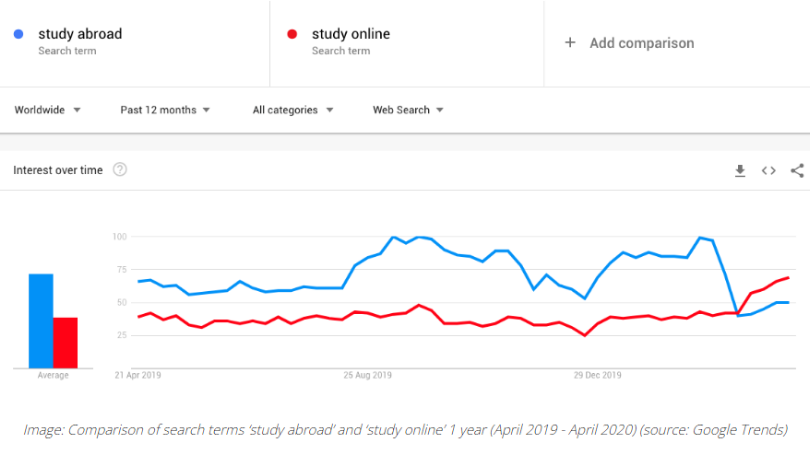
This is because people realized online learning has tons of perks that come with it. These include:
- Earning a certificate or a degree without setting foot in the classroom
- Study while working full-time
- Flexibility to set your own schedule and study anytime
- Interacting with teachers and other students from all over the world
- Getting quality education from some of the best universities in the world
- Organizations saving millions of dollars by not using any physical resources.
Online learning assessments benefit greatly from technological advancements and make things seamless for both students and teachers. This is why they have received tremendous support.
And now that we have cleared the air about what online learning assessments are, let’s look at how these can be beneficial to assess online learning.
Benefits of Online Assessments
Online assessments have already proven themselves to be a necessity for the education systems globally.
However, it does not end there because the benefits of online assessments are way more far-reaching than most people have understood. Let’s take a look at some of them:
1. The Flexibility of Time and Location
This is arguably the most talked-about benefit of online assessments.
Because it makes things convenient, and who doesn’t love convenience, right?
Online assessments can be shared and taken from anywhere and they are monitored remotely by the administrators. There are no such barriers to showing up to a location or dressing up appropriately for the test.
In fact, some assessments are so flexible that they can be taken at any time as test-takers get quite a substantial time window to attempt the test as per their convenience.
2. Less Legwork for Teachers
If you’ve ever conducted online and pen-and-paper assessments, you’d know incredibly stressful the latter is.
As a teacher, you are responsible for printing out multiple copies of the question paper and answer sheets while ensuring that every student shows up on time and is seated in the right place.
But that’s not even 50% of the work. Teachers need to continuously monitor every student on the premises and ensure that they submit their copies on time and don’t take any more than the allotted time.
On the contrary, online assessments require none of those input from teachers as everything is done online by managing a few settings beforehand.
3. Quick Results, Reports, and Analysis
Another major input from the teachers comes in the form of checking or assessing the tests.
But that’s not the case with online assessments.
As a test supervisor, you can let test takers instantly see their results once they are done with their test instead of manually grading every answer.
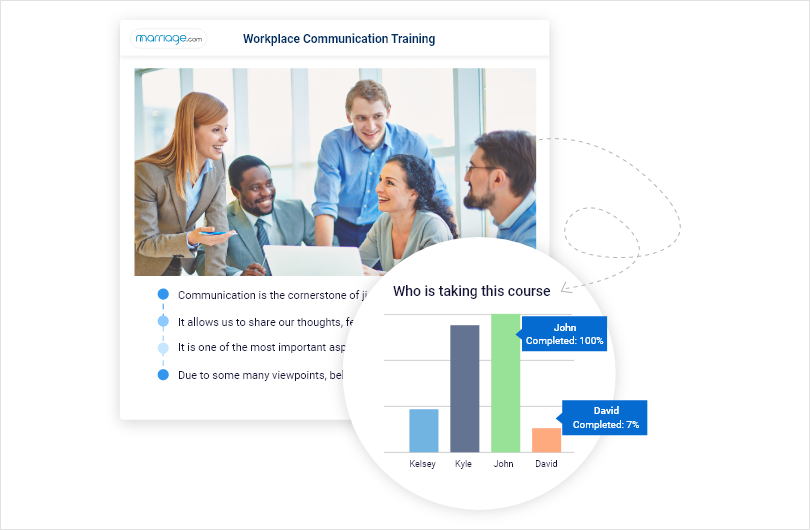
This is done by entering the answers and assigning scores at the time of creating the test. This way students can instantly get their results once they’re done attempting the last question.
Also, the built-in analytics system helps teachers get an insight into their students’ overall performance, along with individual reports of every student.
Students don’t need to wait for days or even weeks anymore to get their test results, and teachers can also generate reports cards of students with just the click of a button to easily assess online. The various types of reports that can be generated include:
- Recent activity reports of learners
- Advanced progress reports
- Time taken per assessment and question reports
- Grade book reports
4. Economical Solution
Another major benefit of online assessment for students is that it is extremely economical to assess online.
Educational institutions can save a massive amount of money as they don’t have to pay for the exams’ physical resources, including paper, transportation, manpower, etc.
They even save a significant amount of money as overhead because the students take assessments from their homes and don’t have to use school premises and their resources like water, electricity, etc.
All of this combined makes online assessments way too economical as compared to traditional assessments.
Read More: Benefits of Using Online Assessments
How Do Assessments Improve Learning?
Online assessments weren’t really a thing a few years ago.
This is why their use and how these assessments can be beneficial might still be unclear to a lot of people.
Online assessments have even managed to pick up some bad rap over the years with respect to their effectiveness and integrity. Most of which remain untrue to this day.
However, their impact on learning has been unprecedented, and they play quite an impactful role in improving students’ learning curve.
Online assessments target multiple angles of the learning process, which provides a better framework for the students’ learning curve.
To give you a clearer perspective, here’s how assessments aid the learning process:
1. Assessments Improve Long-Term Recall
Practice testing or practicing over a long period of time are two of the most effective tactics of improving long-term recall.
Scientists explained that you are more likely to retain a lot more information and easily recall necessary parts of that information whenever needed by practicing information retrieval.
These assessments help students practice repetitively for long periods of time and point out mistakes and improvement areas, which help them retain most of the information which is taught to them in the long run.
2. Assessments Inform Instructors
Assessments also help teachers get an accurate picture of their students’ learnings by collecting information about what and how they are learning certain things.
Everyday formative assessments enable teachers to understand what their students know, what they can do, and what they still need to learn.
These assessments let teachers assess not only the students but also their own techniques of teaching. They can identify students’ patterns and behavior and use test scores; teachers can map out areas that still need improvement, which they can work on to impart knowledge in the best way possible.
3. Assessments Provide Evidence of Learning
Educators, parents, students, and administrators are the stakeholders of the learning process, and they also require evidence to support any claims of the student’s learning process.
Formative and summative assessments provide a balanced framework for assessing students and providing evidence of what the students are learning.
A well-constructed formative and summative assessment system enables students to demonstrate their abilities, learning, and how close they are to meeting their educational goals.
Evidence from assessments is not only to satisfy the stakeholders but is also beneficial for the students. This is because educators can use this evidence to provide students with instructions and information about which concepts and skills they need to learn in order to maximize their learning capabilities.
4. Assessments Help Lower Test Anxiety
Assessments are very closely related to the final graded tests, and repeatedly practicing assessments helps students overcome the fear of those tests. As per research conducted at the Tufts University, Massachusetts, retrieval practice protects memory against acute stress.
Low-stake assessment tests with a similar format can be extremely instrumental for students to practice high-stake assessment tests.
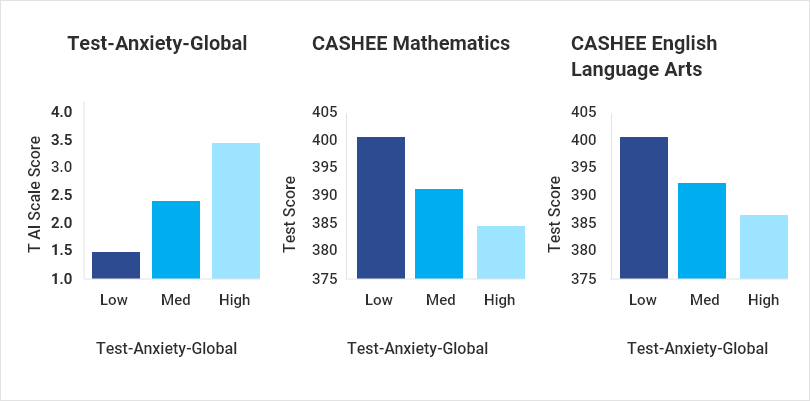
Also, repetitive assessments don’t just teach test-taking skills and calm the nerves; it also help students master their coursework, which boosts their confidence. Preparations through assessments will make students more comfortable tackling different kinds of complex questions during finals, and their developed proficiency will come in handy.
Now that we have gone through the benefits of online assessments, it’s time to look at some of the important ways of assessing learning online.
Related Read– To learn more about some of the benefits of online learning to students, have a look at the Top 6 Benefits of Online Learning for School Students
10 Important Ways to Assess Learning Online
There are several ways of conducting assessments online. Some are more effective than others, but each of them has its own perks.
1. Online Quizzes
There are plenty of different ways to assess students, but quizzes are some of the oldest online assessment tools, and when these quizzes are paired with advanced technological tools, they offer some of the most excellent ways to assess student learning.
Online quizzes can easily be used to assess the learning curve across a wide range of test-takers. You also get the ability to compare and contrast the results of all the test takers across different classes or schools if the students take the same quiz.
Quizzes are also quite flexible because you get the ability to ask all sorts of questions across different question types, including:
- Multiple-choice questions
- Essay questions
- Fill in the blanks
- True or False
- Hotspot
- Comprehension
- Matching
Watch: 15+ Question Types for Online Learning & Assessment
You can also create a baseline measurement of the student’s existing knowledge by giving them a non-graded quiz prior to the start of the course, which a final assessment quiz will follow at the end of the term.
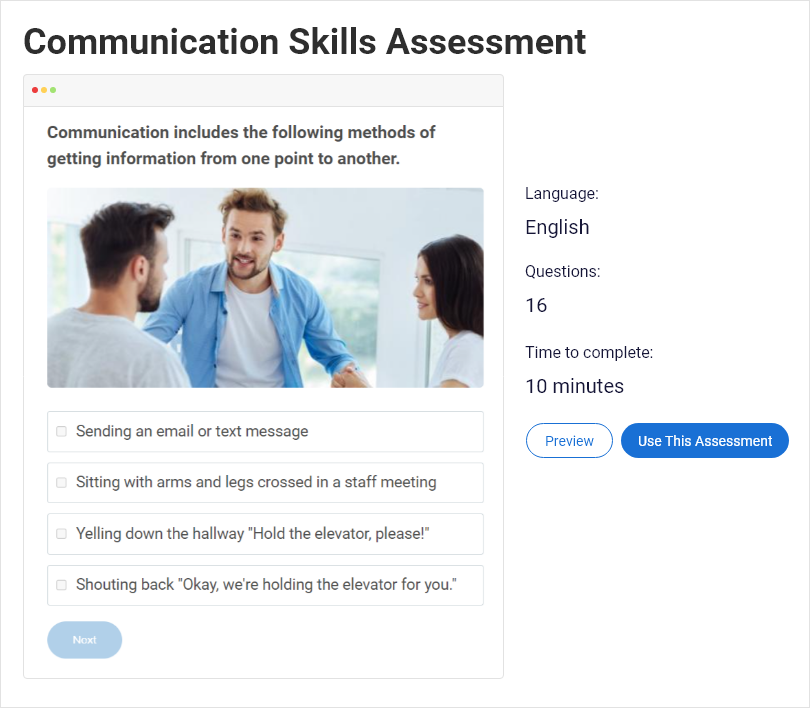
There are tons of different quizzes that you can conduct to test the knowledge of the quiz takers based on different subjects. Here are some of the examples:
- Abstract Reasoning Assessment
- Critical Thinking Assessment
- Analytical and Logical Reasoning Test
- Communication Skill Assessment
- Technical Writing Skill Assessment
Also, one of the fastest ways of building quizzes is by using question banks that are built in the quiz maker software. These quiz banks will give you a huge resource of questions that will be relevant to your quiz subject, and you can simply drag and drop those questions to create a quiz instead of building everything from scratch.
2. Online Interviews
If you want to give learning a more personal touch, you can do that by incorporating video conferences within your online teaching.
Students can easily demonstrate their proficiency in a language, nursing, music, and other domains to qualify for positions that require a specific set of skills.
Nowadays, some online assessment tools offer video interview questions that let quiz makers create questions beforehand. The quiz takers i.e. the students can respond to those questions by uploading a pre-recorded video or recording one at the time of answering the question.
In case there’s a need to conduct such assessments live then web conferencing tools like Zoom can also be used.
Watch: How to Create a Video Interview Question
3. Scenario-Based Questions
One of the best ways of assessing online is by giving your online learners an opportunity to apply their knowledge and learning in practical and realistic scenarios.
Scenario-based questions are so effective because they help students remember and recall the material they have learned and apply it in the scenarios.
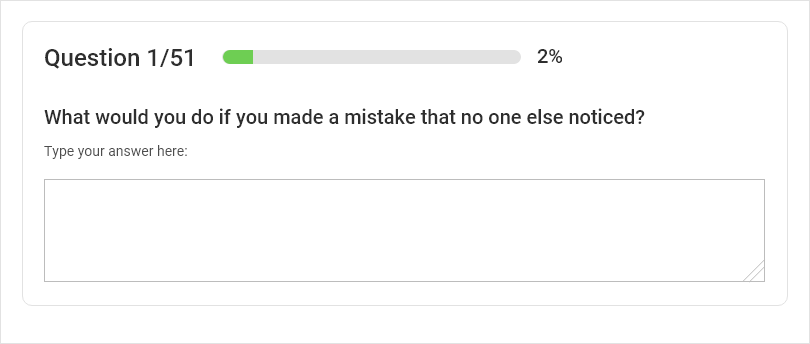
One of the most effective ways of implementing scenario-based questions is to always develop a problem around a situation that is relatable to the learner, which they can see as a possibility in their lives. This creates an avenue for immediate feedback from the students, which will help in assessing their retention skills.
There are several types of scenario-based questions that you can throw at the learners based on the nature of the assessment. These are as follows:
- Skill-based scenario: To demonstrate acquired skills and knowledge.
- Problem-based scenario: To integrate theoretical and practical knowledge for solving a problem.
- Issue-based scenario: To take a stand on issues, usually from a humanitarian perspective, to understand the impact of decision-making.
- Speculative scenario: To predict the outcome of future events based on their knowledge and deduction.
- Gaming scenario: To use games as a learning tool during different scenarios.
4. Peer Evaluation
When learning outside the traditional classrooms, it is extremely important to foster a healthy relationship between the students. You can always assess what your students have learned and also foster a deeper peer connection at the same time using this evaluation.
You can start by assigning each student a virtual peer for a week or pair them on a random basis to get them talking across the class and eventually assessing each other.
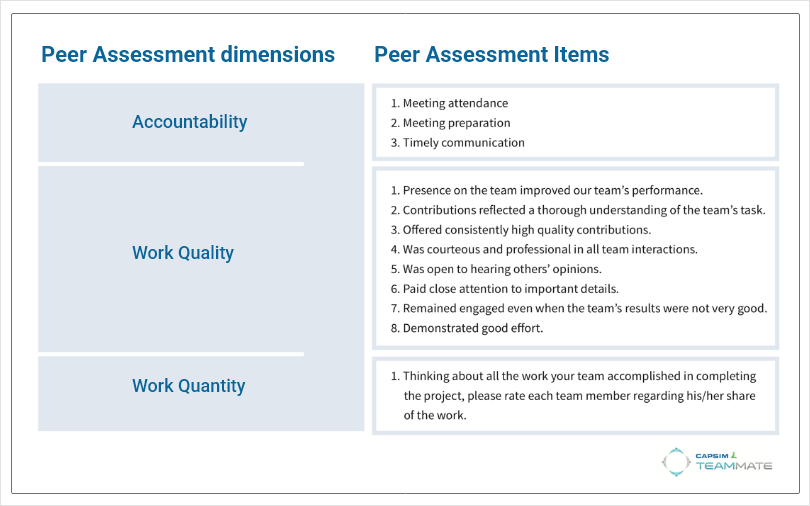
When in pairs, students can be placed in breakout rooms on any video conferencing platform like Zoom to perform the same activities they did back in their classrooms.
Give every student a general rubric to evaluate their peer assessments on and also let them share their feedback with you at the end of the process. You can also record the students teaching concepts to each other and review that footage later to assess them accordingly.
These activities are the most appropriate when it comes to asynchronous learning.
For synchronous learning, you can organize something along the lines of a talk show where you can assign roles to three or four students.
For instance: students can take the role of different inventors or physicists during a physics class. Then, each student will discuss their perspective in front of the class, and their peers will be responsible for probing questions accordingly.
5. Assessment Games
It is a well-known fact that people learn much better when they play, so incorporating assessments during games is one of the most effective ways of evaluation.
Games act as a great resource for practicing knowledge and ideas that have been learned recently. Every decision made in games has consequences, which makes it important for the instructors to observe how certain students make decisions.
Games also empower students to apply their knowledge and skills in real-life situations by learning them practically during games.
There are several types of games that you can instruct students to play, including:
- Adventure games
- Roleplay games
- Reality games
- Puzzles
- Competitions
- Sports games
You can foster a more positive learning environment once you incorporate any of these games into your elearning curriculum. Difficult learning material can be made easy for the students once it is added as a challenge to be achieved in a game.
When gamification is added into an intense course load, it becomes much easier to absorb, but certain things must be kept in mind. They are:
- Introduce a safe but realistic environment for the students.
- Create challenges but also make them achievable.
- Enhance side knowledge development using hypothesis building, problem-solving, strategy development, etc.
- Define objectives that are clear.
- Be fun and keep students engaged.
6. Online Polls
Online polls are a great way of capturing feedback directly from your students about their learning experience.
Measuring anything from learning satisfaction to why students make particular choices during different scenarios.
Online polls are effective because they let students voice their opinions, but they are also quick and easy to take, making them an easy choice.

You can use multiple different question types in your polls when you want to grab your learner’s attention on something important or break the ice during a lengthy activity.
You can easily circulate polls via web conferencing platforms if you host webinars using built-in tools for conducting polls. You can also use specialized online poll makers that will let you create, send and analyze poll results with ease.
There are plenty of poll makers available that will offer you ready-to-use templates for polls, surveys, and quizzes which you can use to automate your entire assessment process through polls.
7. Dipsticks
Dipsticks are quite simple in the way they work. These assessments stand for short, quick checks that the teachers can conduct virtually to ensure that all students are on the same page and also on track both academically and morally.
Teachers can easily do this by posing a simple question at the start of every class about things learned previously or how everyone feels about the learning process.
Students can respond with either emojis, text messages, or simply speaking what they feel. The questions also don’t necessarily have to be serious because even the funny and engaging questions will get relevant answers, if posed correctly.

Some teachers have even taken to Twitter to ask some funny and engaging questions with the students like “Is cereal a soup?” or “Is a hotdog a sandwich?” to see how they think and make decisions.
Teachers can even ask students direct questions about the content they have recently covered and then assess their understanding on a scale of 1 to 5 to find out where the problems exist.
8. Self-Assessment and Retrospective Learning
Self-assessment is another great way of carrying out assessments, and it gives students an opportunity to share their views on the course, process of teaching, performance, and many other things.
Self-assessment is not just a measurement of performance, but it also gives students an opportunity to learn to objectively judge their skills and knowledge.
Another methodology that goes by the name of “agile retrospectives” can be practiced, where students can learn and improve by reflecting on their past events and experiences. The idea of this activity is to let students share their thoughts after every class on a question like:
- What have I learned?
- What worked well?
- What did I enjoy?
- What did not work well?
- What did I find challenging?
- What am I going to do differently?
There are plenty of retrospective activities that can be practiced to derive the lessons learned, and most of them can even be done remotely through video conferencing applications.
9. Open-Ended/Essay Questions
Open-ended or essay-type questions are also a popular way of assessing students qualitatively. They stimulate students to explore their thoughts, feelings, and opinions while teachers can test their overall understanding of a subject.
This type of assessment is best for assessing students online on a higher level of learning because it engages critical thinking because students take a lot of time comprehending, organizing, and composing their answers.
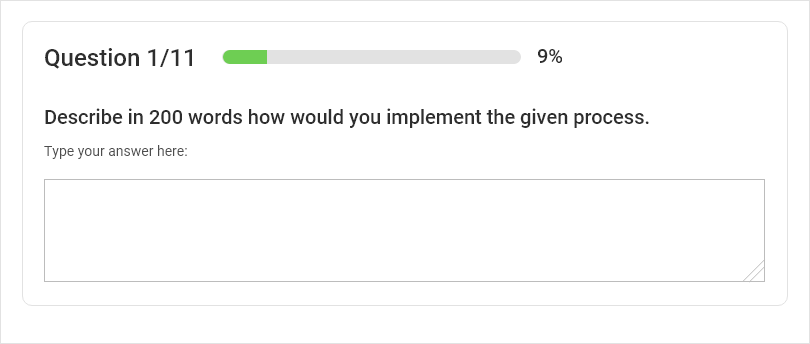
You can easily create open-ended or essay-type questions through a specialized online quiz maker, which gives users the ability to input any answer they like, which the instructors can later review and evaluate.
10. Explanatory Student Videos
Students can be extremely creative, and one way of exploiting this benefit is by asking the students themselves to record and edit videos of their own.
These can be short explanatory videos in which students can present a concept that they have learned in the past. Students can use animation, drawings, interviews, or anything to create their videos and then share them on a common platform so that their classmates can have access to them which they can provide feedback on.
You can also ask students to use social media applications to share their videos depending on how you want to manage your data and how comfortable students are with the platforms.
It all looks quite promising on paper, but let’s look at how institutions apply these techniques in real life to get a better perspective.
Case study: McKeel Academy of Technology
Teachers at McKeel Academy of Technology needed a concrete mechanism to test their students and get an indication of their understanding of the coursework. They also wanted their students to get instant feedback on their assessments, which was impossible through the paper-based tests because grading was time-consuming.
To do so, they used online quiz maker software that helped them decipher which assessments have been taken up by the students and also which ones that have not.
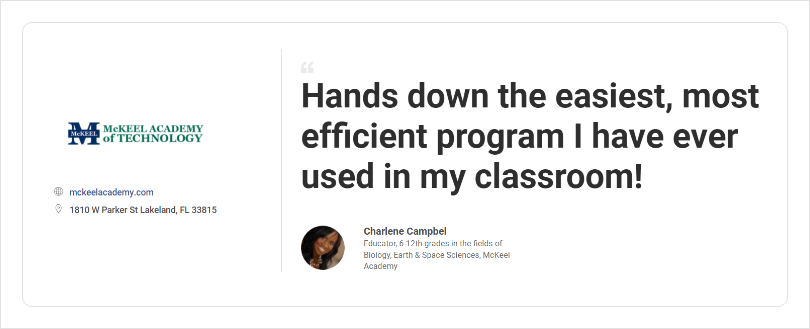
Even the students preferred being assessed online because the results were instantaneous, and they even got quick feedback for the left out and wrong answers.
Teachers were quite pleased with the transition because it made the process completely paperless and seamless as they only have to send a link and students get a randomized assessment test.
To add to that, not having to deal with papers after the test and the speed of delivering assessments helped them drive the quality of education all the way up.
Finally, it’s time to look at some of the important tips that can help you elevate your online assessment techniques.
FREE. All Features. FOREVER!
Try our Forever FREE account with all premium features!
Tips for Evaluating Student Learning Online
When it comes to implementing the solution for online assessment for students, several considerations pop up. It’s completely natural to have questions at first, but some tips can help you get over the paranoia and experience the results for yourself.
Let’s have a look at them:
- Break down assessments into smaller parts and modules if they are lengthy and complicated to easily assess students at different points and outline low-functioning areas.
- Include students in the process of building the assessment and make it everybody’s business to make way for a more exhaustive peer and self-assessment test.
- Provide students with detailed rubrics to accurately communicate what’s expected of them from the assessments.
- Let students express themselves using technology to produce quality and true-to-life assessments that are engaging and will also enhance the learning process.
- Use announcements or emails to deliver feedback to the entire class.
- Consider using self-check and ungraded formative assessments if the course material is complicated to determine if the teaching practices need to be modified.
- Show trust in the academic honesty and integrity of the students, and don’t let paranoia of cheating catch up to you. You can also use an assessment tool that offers settings to prevent cheating by the following means:
- Shuffling of answer options
- Question pooling
- Randomized question display
- Addition of time limit
Assess Online Learning with Ease
Online assessments have proven to be extremely critical in the online learning domain, and they should be taken up with the same level of care and rigor.
Having good online assessment software is equally important for the success of your online assessments.
Designed for this purpose, ProProfs Quiz Maker is one of the most sophisticated online tools in this domain that offers over 100k+ quizzes, with over 10+ question types to assess learners with every possible angle out there. Teachers can create an automatically graded quiz and make the process more seamless for them and test makers.
Also, you don’t need to be a programming genius to assess students online because the processes have evolved to be even simpler than before.
So go out there and find the best exam maker and different ways to assess students with ease.
 Tips
Tips
We’d love to hear your tips & suggestions on this article!
FREE. All Features. FOREVER!
Try our Forever FREE account with all premium features!
 We'd love your feedback!
We'd love your feedback! Thanks for your feedback!
Thanks for your feedback!





